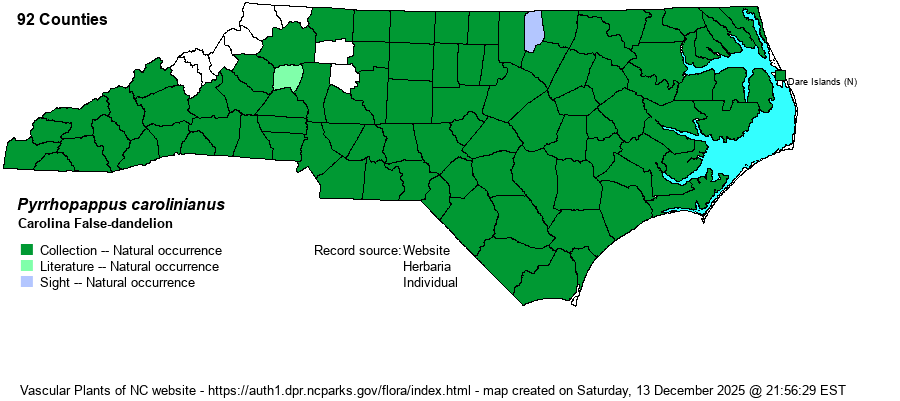| Author | (Walter) de Candolle | |
| Distribution | Nearly throughout the state, but sparse to absent in the northern Mountains.
DE and PA to MO, south to central FL and TX. | |
| Abundance | Common to often abundant in the Coastal Plain; common in the Piedmont, though less so in the foothills; fairly common in the southwestern Mountains in low elevations, but rare to absent in the northern Mountains. | |
| Habitat | Almost always in full sun: dry to moist fields, meadows, roadsides, clearings, powerlines, disturbed pinelands, fallow cropfields. The true natural habitat(s) is not known. | |
| Phenology | Flowering and fruiting late March-July. | |
| Identification | As its name suggests, Carolina False-dandelion has heads and leaves that resemble Common Dandelion. But it can easily be told by its much taller stem -- 1-2.5 (or more) feet, each head flat-topped (vs. rather dome-shaped), and presence of several stem leaves (vs. none). Hairy Cat's-ear (Hypochaeris radicata) is similar, but its heads are deeper yellow and it lacks stem leaves. This native species has bright canary yellow heads that are less "golden" in color than are those of the two exotic species. It is a showy plant, owing partly to its height but also to its lighter yellow flowers. Most people would assume this is just another non-native "dandelion", especially as it is always found in man-influenced habitats. | |
| Taxonomic Comments | Includes variety georgianus.
| |
| Other Common Name(s) | Carolina Desert-chicory, Texas Dandelion | |
| State Rank | S5 | |
| Global Rank | G5 | |
| State Status | | |
| US Status | | |
| USACE-agcp | | |
| USACE-emp | | |

